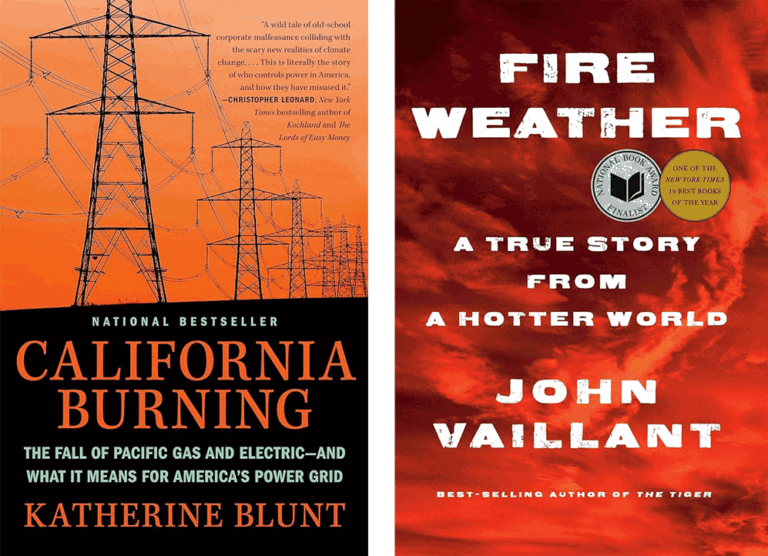
California Burning: The Fall of Pacific Gas and Electric — and What It Means for America’s Power Grid, By Katherine Blunt, Portfolio 2022, 368 pp, $29.00.
Fire Weather: A True Story from a Hotter World, By John Vaillant, Knopf 2023, 432 pp, $17.55
Two books show how wildfires teach crucial risk management lessons. Risk management is an exercise in discipline and imagination. The organization needs the discipline to do what’s right and the imagination to know how bad things can get.
In two books, wildfire teaches those lessons. California Burning by Katherine Blunt shows the toll of lax risk management. Fire Weather by John Vaillant reveals the risk of limited imagination.
California Burning describes the plight of Pacific Gas and Electric. Across a single decade, the company was held criminally responsible for events that killed more than 90 people, most tragically the 2018 Camp Fire that destroyed Paradise, California.
The 2018 Camp Fire is a signal example. The failure of a single hook on an electric tower threw off the sparks that started the fire, which destroyed the town of Paradise and killed 85 people
Blunt is a talented Wall Street Journal reporter. Her writing isn’t flashy, but she clearly describes the technical and regulatory challenges PG&E faced. She doesn’t call the story a failure of risk management, but a risk management professional could easily spot gaps that, if properly addressed, would have helped the company.
The 2018 Camp Fire is a signal example. The failure of a single hook on an electric tower threw off the sparks that started the fire, which destroyed the town of Paradise and killed 85 people. The utility pleaded guilty to 85 counts of manslaughter. The faulty hook cost 56 cents. It had been purchased in 1921.
It’s true that 100 years ago few would have collected, preserved and collated such a trivial purchase, but PG&E suffered from inadequate data preservation.
Blunt sprinkles tales of data inadequacy throughout: inaccurate leak surveys, inspection teams rewarded for not finding leaks, failure to modernize record-keeping as the law required, spreadsheeting of permanent regulatory reports.
Weak data hurts data-driven processes like knowing which power lines to inspect and what parts to replace.
There were chances to fix things. The utility’s gas division modernized record-keeping and equipment monitoring six years before the Camp Fire. Unfortunately, that was after a PG&E gas line exploded in San Bruno, California, killing eight and destroying 38 homes.
After that cleanup, the head of the gas works suggested that the electric division do the same. It chose not to.
PG&E instead developed a corporate culture that put shareholders and profits over safety. The starkest evidence came from a PowerPoint that set grounds for debate at a corporate retreat.
One slide showed, “What Is Not Up For Debate.”
Bullet Point No. 1: 8% growth in earnings per share.
The next slide showed “What Is Up For Debate.” Among the debatable: “Safety” and “Reliability.”
The very existence of such a slide is evidence that the company didn’t adequately consider the reputational risk of a profits-over-safety culture.
More typically, utility leaders would complain that the mathematical formula for setting rates discouraged spending on safety (see sidebar.)
Even at its nadir, PG&E put profits first. It pleaded guilty to dozens of manslaughter charges rather than accepting a plea deal that carried a bigger fine.
Regulators didn’t help. Over the decades, the state pushed utilities hard — first into a complex, untenable deregulation that failed almost immediately, then into a renewable energy drive that drove costs higher — which became another reason to skimp on safety.
As the utility soldiered along, California fell into the weather extremes that characterize climate change. Southern California utilities had to develop strategies to minimize wildfire risk, but regulators required less of northern utilities like PG&E.
That is not an excuse.
Regulators provide a floor for appropriate behavior, but companies need to do better. Drought is part of California’s ecosystem. By my count, the state has experienced nine droughts across the life of the utility. Climate change wasn’t going to make that better.
By failing to manage its risks, PG&E hollowed itself and underserved both investors and customers.
Fire Weather addresses only one risk management challenge — the Lucretius Problem, named after the Roman poet/philosopher: Humans struggle to imagine things more extreme than they have experienced.
We can’t picture, let alone understand the dynamics of, say, a river wider than one we’ve seen, or a person a foot taller than anyone we’ve actually met, unless we have visited the Amazon delta or have a chum eight and a half feet tall.
Author John Vaillant tells how wildfire consumed the Canadian oil town of Fort McMurray in May 2016. Per Lucretius, everything in the story strains credulity.
The town sits deep in the absurdly cold forests of Northern Alberta. The winter cold can shatter a bulldozer blade. The fire department’s pumper truck has a heater so the water to put out the fire doesn’t freeze en route.
People there work for oil companies. They don’t extract oil, but bitumen, which is essentially road tar. Companies separate the bitumen sludge from the soil it permeates, then reverse engineer the goop back to sweet crude.
The tools to do this invoke Lucretius again: bulldozers three stories tall with tires that cost $85,000 apiece; a bitumen crusher that Vaillant describes as “a mechanical black hole . . . that can consume a city bus in three seconds.”
The Fort McMurray fire itself represents an unimaginable level of destruction. It melted aluminum, vaporized lawn mowers and spawned its own weather patterns. It burned for 15 months.
As the fire approaches town, the Lucretius Problem befuddles town leaders. On the morning the town is evacuated, their advice is not to flee or to prepare to flee. They recommended that everyone “have a plan.”
Evacuation was chaos. It is remarkable no one died.
Describing this all creates a Lucretius Problem for the writer. Vaillant solves it with careful research and vivid writing. After the fire, “nothing moved on the street now; even the ravens had fled.”
He anthropomorphizes the fire; he gives it intelligence and desire. It is Godzilla, Moby Dick, Gilgamesh. It prowls the landscape; it devours buildings as snacks.
Five minutes from a nanny cam become their own Blair Witch Project, a panorama of horror. A did-I-see-something flicker outside the window cascades into “a malevolent entity from another dimension breaking through to this one.”
The final Lucretius Problem is our own. Vaillant devotes the last third of the book to how climate change has turned the natural wildfire into the Beast. Extreme as northern Alberta is, its environment did not evolve to fire-welcoming, 90-degree spring days with 10% humidity. Spewing carbon dioxide into the atmosphere for going on two centuries has thrown the planet off kilter. The voracious chemical process that is fire is beneficiary.
Vaillant’s final point is one a risk manager might make and one that California Burning echoes. The failure to confront risk leaves us vulnerable. The worst that can happen is far worse than anything we can imagine.
Jim Lynch, FCAS, MAAA, is retired from his position as chief actuary at Triple-I and has his own consulting firm.
Rating Formulas and Safety
The first time I read it, well, I had to re-read it.
PG&E employees were discouraged from spending on safety because there was no profit in it. California Burning author Katherine Blunt mentions the issue several times. For example:
The middle manager is responsible for overseeing two budgets: maintenance spending and capital spending. If the manager invests $1.00 in capital, he gets $1.20 back. Spending $1.00 on maintenance, meanwhile, is just $1.00 out the door – often with no obvious result or reward. (p. 215)
Inspections and other precautions, of course, are not capital spending.
This sounded so crazy I assumed I misunderstood the author, or the author misunderstood the situation.
The issue stems from rate regulation. Utilities, like U.S. insurers, have regulated rates. State officials approve what a utility charges, often after considerable discussion. The basic formula is:
Total revenue requirement = rate base x allowed rate of return + expenses.
Rate base is the depreciated value of the utility’s assets.
Going back to the passage from Blunt’s book: The middle manager is encouraged to allocate resources to capital spending and improvements. At the next rate hearing, regulators will let the company earn a return, say 11%, on the capital expenditure.
A safety program, though, is an expense. The regulator lets the utility recoup the expense but earn no profit from it.
This incentive structure is so well-known in utility circles it has a name and even a Wikipedia page: the Averch-Johnson effect. (The original paper emphasizes overinvestment in capital rather than underinvestment in safety.)
The utilities’ formula differs from the standard ratemaking formula actuaries learn, which I’ll simplify a bit here:
Rate = (pure premium + fixed expenses)/(1.0- variable expenses – profit).
Note that additional expenses, whether fixed or variable, increase profits.
Is the utility formula faulty? Is the insurance formula?
Stephen Mildenhall acknowledges that he is not an expert in utility pricing, but the CAS Fellow did write, with John Major, Pricing Insurance Risk: Theory and Practice. Mildenhall points out that a valid pricing of insurance could mimic the function utilities use:
Revenue required = expected losses + expenses + cost of capital.
Ultimately, market pressures determine the premium charged.
Neither formula is flawed. The failure would lie in how the formula is interpreted and used. Either the utility or the regulator could err in this way.
Safety expenditures, he noted, should not be considered in isolation. They generate an implied return of their own, in the form of lower expected losses from accidents.
I would add that all utilities face this constraint, but few if any have blundered safety issues as thoroughly as PG&E has.
Sources
Harvey Averch and Leland L. Johnson, “Behavior of the Firm Under Regulatory Constraint,” The American Economic Review, December 1962.
Coley Girouard, “How Do Electric Utilities Make Money?,” Advanced Energy Perspectives, April 23, 2015.
Mark A. Jamison, “Rate of Return: Regulation,” Public Utility Research Center, undated.













